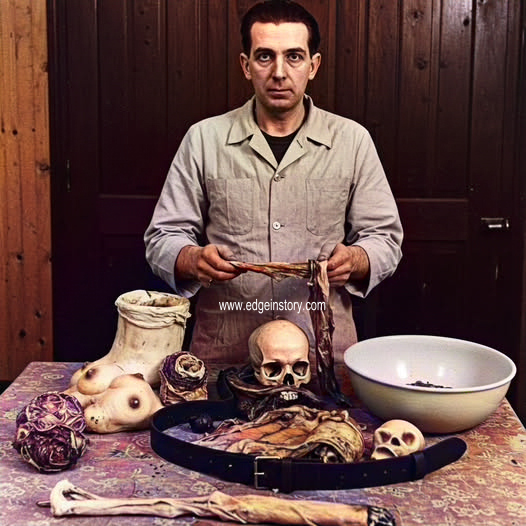Complete List of Evidence Found in Ed Gein’s Farmhouse
On November 16, 1957, authorities investigating the disappearance of hardware store owner Bernice Worden entered the isolated farmhouse of Edward Gein near Plainfield, Wisconsin. What they discovered inside would become one of the most shocking crime scenes in American crime history, revealing a macabre collection of human remains and grotesque artifacts that would later inspire countless horror films and shock not just a nation but the entire world.
The Initial Discovery
Bernice Worden’s Body
- Found in the woodshed, hanging upside down by her ankles from a crossbar
- Body was decapitated, gutted, and “dressed out like a deer”
- Shot with a .22-caliber rifle
- Mutilations were performed after death
Worden’s Remains
- Head found in a burlap sack
- Heart discovered on a plate in the dining room
- Internal organs found in a bucket
- Heart also found hanging in a plastic bag
Human Skulls and Skeletal Remains
Skulls
- Four complete human skulls
- Five human heads wrapped in plastic bags
- Skulls used as soup bowls (crown of skulls converted to bowls)
- Skulls mounted on bedposts as decorations
- One human head hanging on the wall
Other Skeletal Elements
- Table propped up by human shinbones
- Various bones, both whole and fragmented, scattered throughout the house
- Musical instruments found among the remains
Skin-Based Artifacts and Clothing
Face Masks and “Death Masks”
- Ten “death masks” made by removing face and hair from human heads
- Human facial skins carefully peeled from corpses and used as masks
- Some masks had lipstick applied and looked “perfectly natural”
- Faces stuffed with newspapers and mounted like hunting trophies on walls
“Woman Suit” and Clothing Items
- A complete “woman suit” – a vest made of preserved female flesh with breasts and sexual organs attached
- “Mammary vest” flayed from the torso of a woman
- Skin from the upper torso of a woman, rolled up on the floor
- Leggings made from human leg skin
Furniture and Household Items Made from Skin
- Chair upholstered in human skin
- Multiple chairs with human skin upholstery
- Lampshades made of human faces and covered in flesh pulled taut
- Wastebasket made of skin
- Decorative bracelets made out of human skin
Body Parts and Organs
Preserved Organs
- Various organs stored in jars
- Organs found in the refrigerator
- A heart sitting on the stove
Specific Body Parts
- Belt made of carved-off female nipples (described as “belt made from human nipples”)
- Four human noses
- Two sets of lips
- Collection of female genitalia
- Shoebox full of female genitalia
- Sex organs from various victims
- Genitals from what appeared to be teenage victims
Additional Human Remains
Mary Hogan’s Remains
- Head of Mary Hogan (tavern owner who disappeared in 1954)
- Found inside the house during the investigation
Estimated Total
- Scattered remains from an estimated 15 bodies total
- Remains of 15 women found throughout the property
- Evidence suggested systematic grave robbing from local cemeteries
Crime Scene Conditions
House Layout
- Most of the house was cluttered, filthy, and in complete disarray
- Kitchen described as “junk-littered” and “utterly chaotic”
- Mother’s room kept spotless and preserved exactly as it was when she died
- Several rooms sealed off and maintained in mint condition as shrines to his mother
Evidence Preservation
- All artifacts were photographed at the state crime laboratory
- Items were subsequently “decently disposed of”
- Only one piece of evidence from the case survives today (housed at a museum)
Investigation Details
Gein’s Confession
- Admitted to making 40 nocturnal visits to three local graveyards between 1947-1952
- Confessed to exhuming recently buried middle-aged women who resembled his mother
- Stated he tanned the skins to make his “paraphernalia”
- Denied having sexual contact with the bodies, claiming “they smelled too bad”
Suspected Additional Victims
- Teenage genitals found suggested possible connection to missing girls:
- Evelyn Hartley, 15, disappeared October 1953
- Georgia Jean Weckler, 8, disappeared May 1947
- Both cases were never solved
The Aftermath
The farmhouse was boarded up immediately after the investigation to protect the evidence that police had found. In March 1958, approximately one year after the discovery, the house mysteriously burned down amid rumors it might be turned into a museum. The cause of the fire was never officially determined, though arson was suspected.
This horrific collection of evidence not only provided proof of Gein’s crimes but also revealed the extent of his psychological deterioration following his mother’s death in 1945. The artifacts demonstrated his obsession with creating a “woman suit” that would allow him to literally become his mother, a delusion that had driven him to murder and grave robbing for over a decade.
The evidence found in Ed Gein’s farmhouse would go on to inspire some of cinema’s most iconic horror villains, including Norman Bates in Psycho, Leatherface in The Texas Chain Saw Massacre, and Buffalo Bill in The Silence of the Lambs.


Leave a Reply